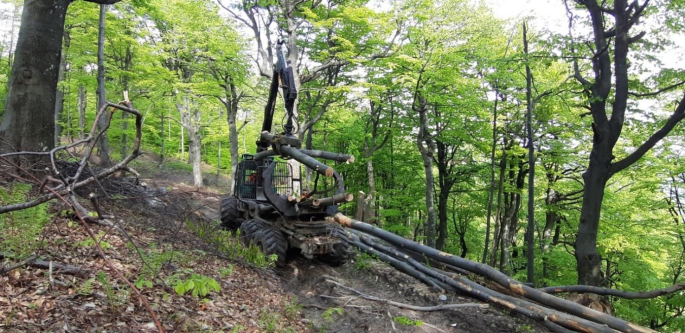在阔叶林中使用组合货代的森林作业
IF 1.8
3区 农林科学
Q2 FORESTRY
引用次数: 0
摘要
在过去的十年中,森林经营部门的技术创新使得机械化水平可以替代农业拖拉机和动物伐木。这些机器被用来装载原木从滑行道和移动原木到下一桩,直到装载空间被完全装载。幸运的是,近年来林业机械化新技术进步的发展创造了一种替代操作的地面系统,使用联合货代进行木材运输。这些创新机器的优点是,只有一台机器可以执行日志群集和主要传输。实际上,用绞车把树干从树桩拉到路上,用链锯横切后,由货代的起重机将原木装载到码头,在那里用起重机将原木成堆地卸下。本研究的目的是分析操作时间消耗,估计在山毛榉林中使用内置单滚筒绞车的联合货代的生产率,评估货代和绞车距离,机器每转运输的原木体积,以及提取成本。这项研究是在保加利亚西巴尔干山脉的山毛榉林中进行的低强度防护林扦插。在相似条件下,联合搬运的平均生产率为7.09 m 3 PMH−1和6.11 m 3 SMH−1,与电缆滑橇和搬运接近。所研究的联合货代的净成本计算为每生产机器小时25.33欧元,每立方米4.13欧元。可变成本占主导地位(70%),其次是劳动力成本(22%)和固定成本(8%)。使用组合货代为链锯操作员提供了便利,因为有些作业是在路边进行的,工作条件较好:地势平坦,并支持横切阶段。研究结果对引进和整合联合运输系统与防护林系统,实现落叶森林采伐的经济效益和环境效益具有重要意义。本文章由计算机程序翻译,如有差异,请以英文原文为准。

Forest Operations Using a Combi–Forwarder in Deciduous Forests
Abstract In the last decade, technological innovation in the forest operations sector has allowed levels of mechanization alternative to agricultural tractors and animal logging. These machines are used to load logs from skid roads and move logs to the next pile, until the load space is fully loaded. Fortunately, in recent years the development of new technological progresses in forestry mechanization created an alternative operation on ground-based system with the use of a combi-forwarder for wood forwarding. These innovative machines have the advantage that only one machine can perform logs bunching and primary transport. Infact, pull stems by the winch from the stump to the road, after they have been cross-cutted by chainsaws, it loads by the forwarder’s crane the logs and transports them to the landing, where they are unloaded with the crane in piles. The aim of the present study was to analyse the operational time consumption, to estimate the productivity of the combi–forwarder with a built-in single-drum winch in beech stands evaluating the forwarding and winching distances, log’s volume transported per turn by the machine, as well as the extracting costs. The study was conducted in low-intensity shelterwood cuttings in beech forest, located in Western Balkan Mountains, Bulgaria. The mean productivity of the combi–forwarder was 7.09 m 3 PMH − 1 and 6.11 m 3 SMH − 1 close to that of the cable skidders and forwarders in similar conditions. The net costs for the studied combi–forwarder were calculated of 25.33 € per productive machine hour and 4.13 € per m 3 . The variable costs (70%) have a leading role, followed by labour costs (22%) and fixed costs (8%). The use of a combi-forwarders facilitates chainsaw operators, as some of the operations are carried out at the roadside in better working conditions: flat terrain and support of the crosscutting phase. The results from the study are useful to introduce and to integrate the combi–forwarders with shelterwood systems and to achieve economic and environmental efficiency of timber harvesting in deciduous forests.
求助全文
通过发布文献求助,成功后即可免费获取论文全文。
去求助
来源期刊

Small-Scale Forestry
FORESTRY-
CiteScore
3.10
自引率
6.70%
发文量
39
审稿时长
>12 weeks
期刊介绍:
Emerging from discussions within IUFRO’s Small-scale Forestry group, Small-scale Forestry was originally published as Small-scale Forest Economics, Management and Policy in 2002, with a view to providing an international forum for publishing high quality, peer-reviewed papers on pure and applied research into small-scale forestry. Although of particular interest to the global research community, the journal is also relevant to both policy makers and forest managers.
The scope of the journal is necessarily quite broad, given the range of issues relevant to small-scale forestry. These include the social, economic and technical dimensions of farm, family, non-industrial, agro- and community forestry. Papers are accepted on the basis that they relate specifically to forestry at this scale, and that they are based on high quality research using accepted quantitative and/or qualitative methodology.
Empirical, theoretical, modeling, and methodological papers are all welcome. The following research areas are particularly relevant to the journal:
-the role of small-scale forestry in rural development-
financial modeling and decision support systems-
enhancing return from non-wood products-
social impacts of small-scale forestry-
marketing, forest co-operatives and growers organizations-
role and effectiveness of government support and subsidies-
innovative research techniques-
education and extension-
certification-
silvicultural, wood harvesting and processing techniques and technologies-
impediments to small-scale forestry development-
monitoring socio-economics-
forest management behaviour and timber supply
 求助内容:
求助内容: 应助结果提醒方式:
应助结果提醒方式:


